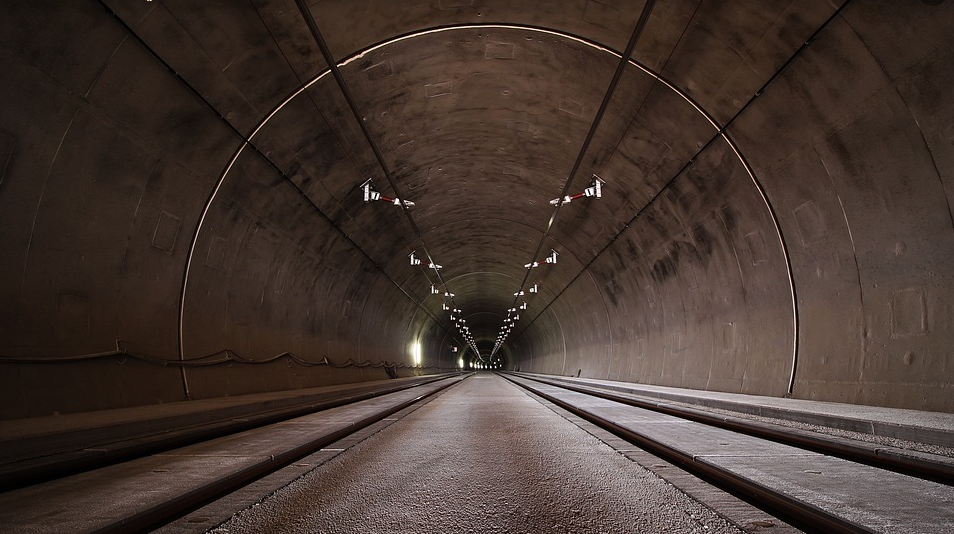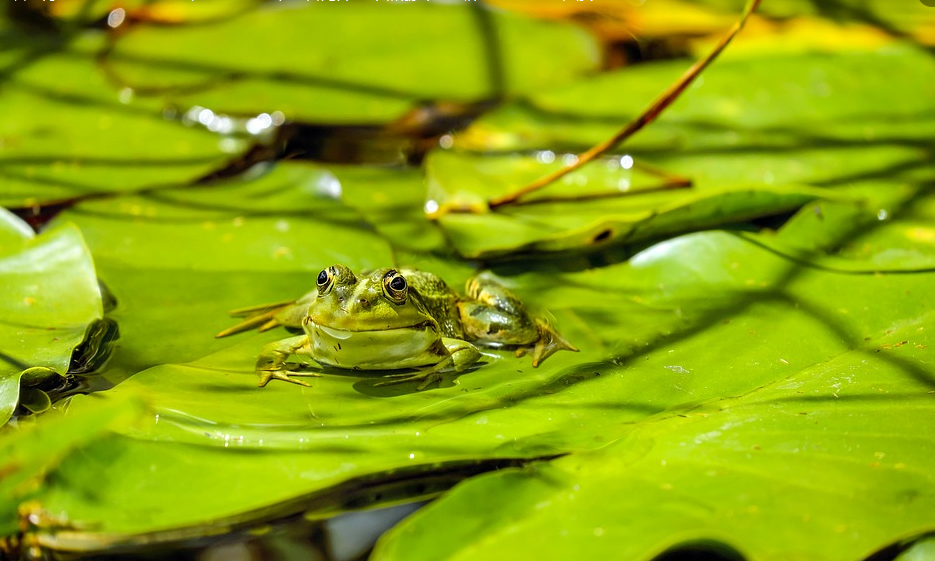新东方背诵50篇36-40
|
36.Plate Tectonics and Sea-floor Spreading The theory of plate tectonics describes the motions of the lithosphere, the comparatively rigid outer layer of the Earth that includes all the crust and part of the underlying mantle. The lithosphere(n.[地]岩石圈)is divided into a few dozen plates of various sizes and shapes, in general the plates are in motion with respect to one another. A mid-ocean ridge is a boundary between plates where new lithospheric material is injected from below. As the plates diverge from a mid-ocean ridge they slide on a more yielding layer at the base of the lithosphere. Since the size of the Earth is essentially constant, new lithosphere can be created at the mid-ocean ridges only if an equal amount of lithospheric material is consumed elsewhere. The site of this destruction is another kind of plate boundary: a subduction zone. There one plate dives under the edge of another and is reincorporated into the mantle. Both kinds of plate boundary are associated with fault systems, earthquakes and volcanism, but the kinds of geologic activity observed at the two boundaries are quite different. The idea of sea-floor spreading actually preceded the theory of plate tectonics. In its original version, in the early 1960’s, it described the creation and destruction of the ocean floor, but it did not specify rigid lithospheric plates. The hypothesis was substantiated soon afterward by the discovery that periodic reversals of the Earth’s magnetic field are recorded in the oceanic crust. As magma rises under the mid-ocean ridge, ferromagnetic minerals in the magma become magnetized in the direction of the magma become magnetized in the direction of the geomagnetic field. When the magma cools and solidifies, the direction and the polarity of the field are preserved in the magnetized volcanic rock. Reversals of the field give rise to a series of magnetic stripes running parallel to the axis of the rift. The oceanic crust thus serves as a magnetic tape recording of the history of the geomagnetic field that can be dated independently; the width of the stripes indicates the rate of the sea-floor spreading. 37 Icebergs Icebergs are among nature’s most spectacular creations, and yet most people have never seen one. A vague air of mystery envelops them. They come into being ----- somewhere ------in faraway, frigid waters, amid thunderous noise and splashing turbulence, which in most cases no one hears or sees. They exist only a short time and then slowly waste away just as unnoticed. Objects of sheerest beauty they have been called. Appearing in an endless variety of shapes, they may be dazzlingly white, or they may be glassy blue, green or purple, tinted faintly of in darker hues. They are graceful, stately, inspiring ----- in calm, sunlight seas. But they are also called frightening and dangerous, and that they are ---- in the night, in the fog, and in storms. Even in clear weather one is wise to stay a safe distance away from them. Most of their bulk is hidden below the water, so their underwater parts may extend out far beyond the visible top. Also, they may roll over unexpectedly, churning the waters around them. Icebergs are parts of glaciers that break off, drift into the water, float about awhile, and finally melt. Icebergs afloat today are made of snowflakes that have fallen over long ages of time. They embody snows that drifted down hundreds, or many thousands, or in some cases maybe a million years ago. The snows fell in polar regions and on cold mountains, where they melted only a little or not at all, and so collected to great depths over the years and centuries. As each year’s snow accumulation lay on the surface, evaporation and melting caused the snowflakes slowly to lose their feathery points and become tiny grains of ice. When new snow fell on top of the old, it too turned to icy grains. So blankets of snow and ice grains mounted layer upon layer and were of such great thickness that the weight of the upper layers compressed the lower ones. With time and pressure from above, the many small ice grains joined and changed to larger crystals, and eventually the deeper crystals merged into a solid mass of ice. 38 Topaz Topaz is a hard, transparent mineral. It is a compound of aluminum, silica, and fluorine. Gem topaz is valuable. Jewelers call this variety of the stone “precious topaz”. The best-known precious topaz gems range in color from rich yellow to light brown or pinkish red. Topaz is one of the hardest gem minerals. In the mineral table of hardness, it has a rating of 8, which means that a knife cannot cut it, and that topaz will scratch quartz. The golden variety of precious topaz is quite uncommon. Most of the world’s topaz is white or blue. The white and blue crystals of topaz are large, often weighing thousands of carats. For this reason, the value of topaz does not depend so much on its size as it does with diamonds and many other precious stones, where the value increases about four times with each doubling of weight. The value of a topaz is largely determined by its quality. But color is also important: blue topaz, for instance, is often irradiated to deepen and improve its color. Blue topaz is often sold as aquamarine and a variety of brown quartz is widely sold as topaz. The quartz is much less brilliant and more plentiful than true topaz. Most of it is variety of amethyst: that heat has turned brown. NOTE: topaz / 'tэupжz; `topжz/ n (a) [U] transparent yellow mineral 黄玉(矿物). (b) [C] semi-precious gem cut from this 黄玉; 黄宝石. 39 The Salinity of Ocean Waters If the salinity of ocean waters is analyzed, it is found to vary only slightly from place to place. Nevertheless, some of these small changes are important. There are three basic processes that cause a change in oceanic salinity. One of these is the subtraction of water from the ocean by means of evaporation--- conversion of liquid water to water vapor. In this manner the salinity is increased, since the salts stay behind. If this is carried to the extreme, of course, white crystals of salt would be left behind. The opposite of evaporation is precipitation, such as rain, by which water is added to the ocean. Here the ocean is being diluted so that the salinity is decreased. This may occur in areas of high rainfall or in coastal regions where rivers flow into the ocean. Thus salinity may be increased by the subtraction of water by evaporation, or decreased by the addition of fresh water by precipitation or runoff. Normally, in tropical regions where the sun is very strong, the ocean salinity is somewhat higher than it is in other parts of the world where there is not as much evaporation. Similarly, in coastal regions where rivers dilute the sea, salinity is somewhat lower than in other oceanic areas. A third process by which salinity may be altered is associated with the formation and melting of sea ice. When sea water is frozen, the dissolved materials are left behind. In this manner, sea water directly materials are left behind. In this manner, sea water directly beneath freshly formed sea ice has a higher salinity than it did before the ice appeared. Of course, when this ice melts, it will tend to decrease the salinity of the surrounding water. In the Weddell Sea Antarctica, the densest water in the oceans is formed as a result of this freezing process, which increases the salinity of cold water. This heavy water sinks and is found in the deeper portions of the oceans of the world. NOTE: salinity / sэ'linэti; sэ`linэti/ n [U] the high salinity of sea water 海水的高含盐量. -à>>saline / 'seilain; US -li:n; `selin/ 1.adj [attrib 作定语] (fml 文) containing salt; salty 含盐的; 咸的: * a saline lake 盐湖 * saline springs 盐泉 * saline solution, eg as used for gargling, storing contact lenses, etc 盐溶液(如用于漱喉、存放隐形眼镜等). 2. n [U] (medical 医) solution of salt and water 盐水. 40 Cohesion-tension Theory Atmospheric pressure can support a column of water up to 10 meters high. But plants can move water much higher; the sequoia tree can pump water to its very top more than 100 meters above the ground. Until the end of the nineteenth century, the movement of water in trees and other tall plants was a mystery. Some botanists hypothesized that the living cells of plants acted as pumps. But many experiments demonstrated that the stems of plants in which all the cells are killed can still move water to appreciable heights. Other explanations for the movement of water in plants have been based on root pressure, a push on the water from the roots at the bottom of the plant. But root pressure is not nearly great enough to push water to the tops of tall trees. Furthermore, the conifers, which are among the tallest trees, have unusually low root pressures. If water is not pumped to the top of a tall tree, and if it is not pushed to the top of a tall tree, then we may ask: how does it get there? According to the currently accepted cohesion-tension theory, water is pulled there. The pull on a rising column of water in a plant results from the evaporation of water at the top of the plant. As water is lost from the surface of the leaves, a negative pressure, or tension, is created. The evaporated water is replaced by water moving from inside the plant in unbroken columns that extend from the top of a plant to its roots. The same forces that create surface tension in any sample of water are responsible for the maintenance of these unbroken columns of water. When water is confined in tubes of very small bore, the forces of cohesion (the attraction between water molecules) are so great that the strength of a column of water compares with the strength of a steel wire of the same diameter. This cohesive strength permits columns of water to be pulled to great heights without being broken. |








